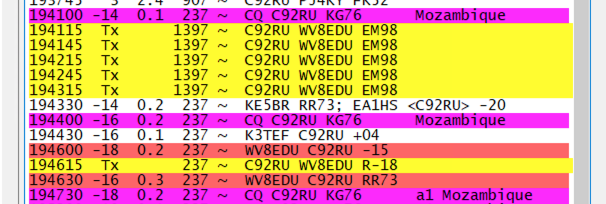There’s currently a DXpedition to Mozambique operating as C92RU. I’ve been having trouble making a contact with the crew there, which surprised me a bit given how easily I contacted the same group a few weeks ago when they were in Botswana operating as A25RU. I thought I would share the process I finally used to get the FT8 QSO.
I had previously used DXSummit to look for “spots” – that is, to see when A25RU was active making FT8 contacts, and which frequency(ies) they were operating on. I started looking for C92RU the same way. However, I couldn’t ever hear them calling CQ or answering others. I could hear plenty of people calling them, but for days didn’t hear them at all.
Yesterday I stumbled on a feature in DX Summit that I hadn’t seen before. If you click on the name of the DX station you’re trying to spot, you get several options:
When I clicked on the VOACAP Predictions, the following graph popped up:
This chart took a minute to interpret. Each slice of the pie is an hour listed in UTC. As you can see below the “0”, each circular band within the graph represents a frequency band. The color-coding in these band slices indicates how likely it is that you’ll be able to establish a contact. I was very keen to see that today, at 19 UTC on 15m, the likelihood of succeeding was in the upper 70%s. So I set an alarm (3:00pm local) to help me remember to start paying attention then.
When the time came, I looked at the recent spots to see what frequencies C92RU was operating FT8 on. I loaded up WSJT-Z and listened to see if I could hear them. It took a few minutes, but eventually I heard them coming back to other stations. Then they called CQ, I responded, and I quickly got the contact.
The VOACAP Prediction tool made it MUCH easier to find C92RU on the air. I’ll definitely be using this capability more in the future.



